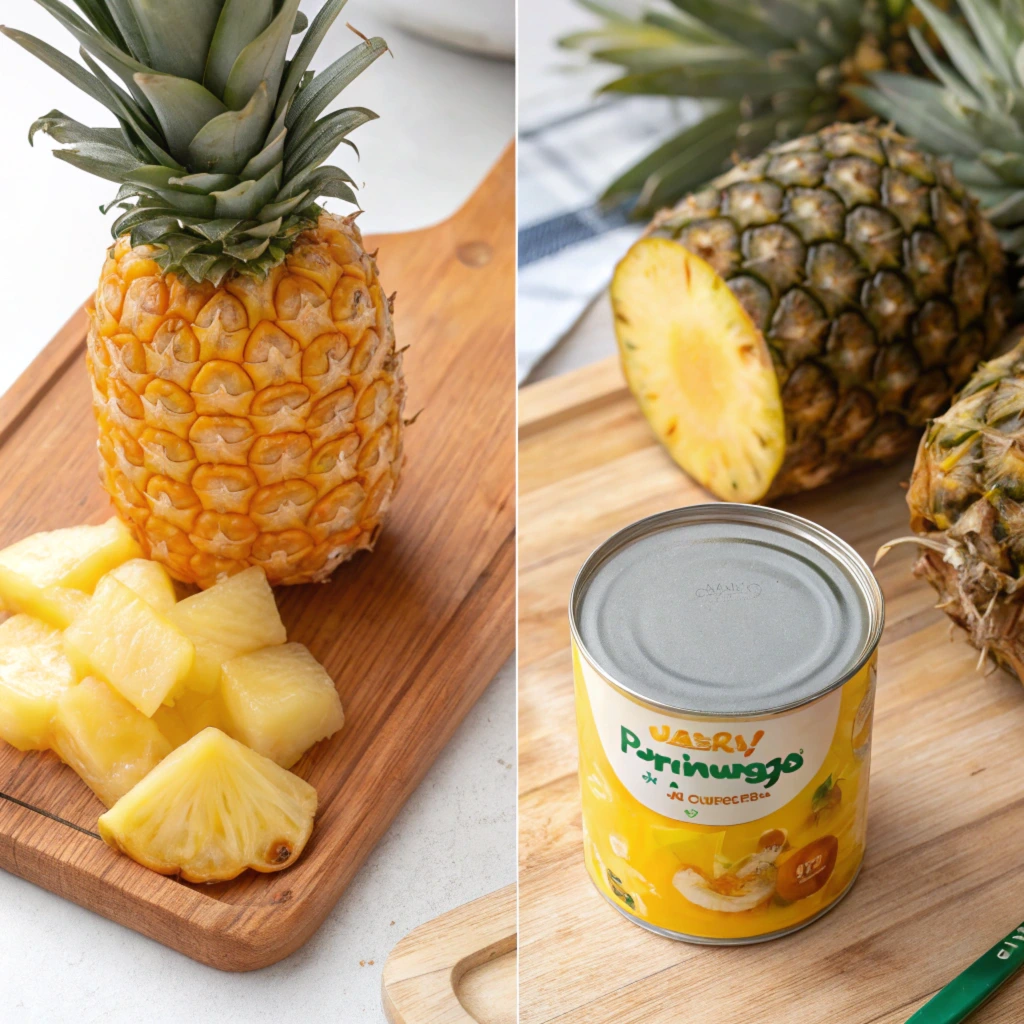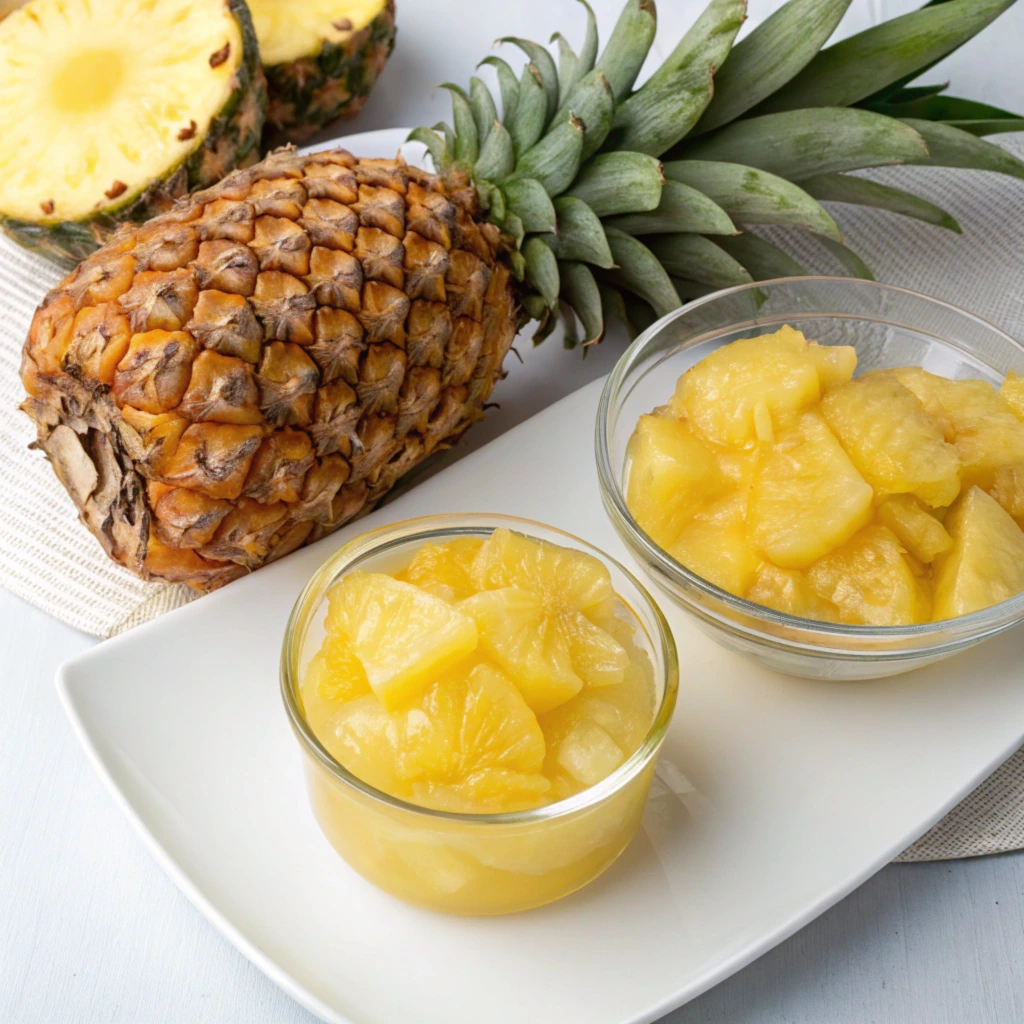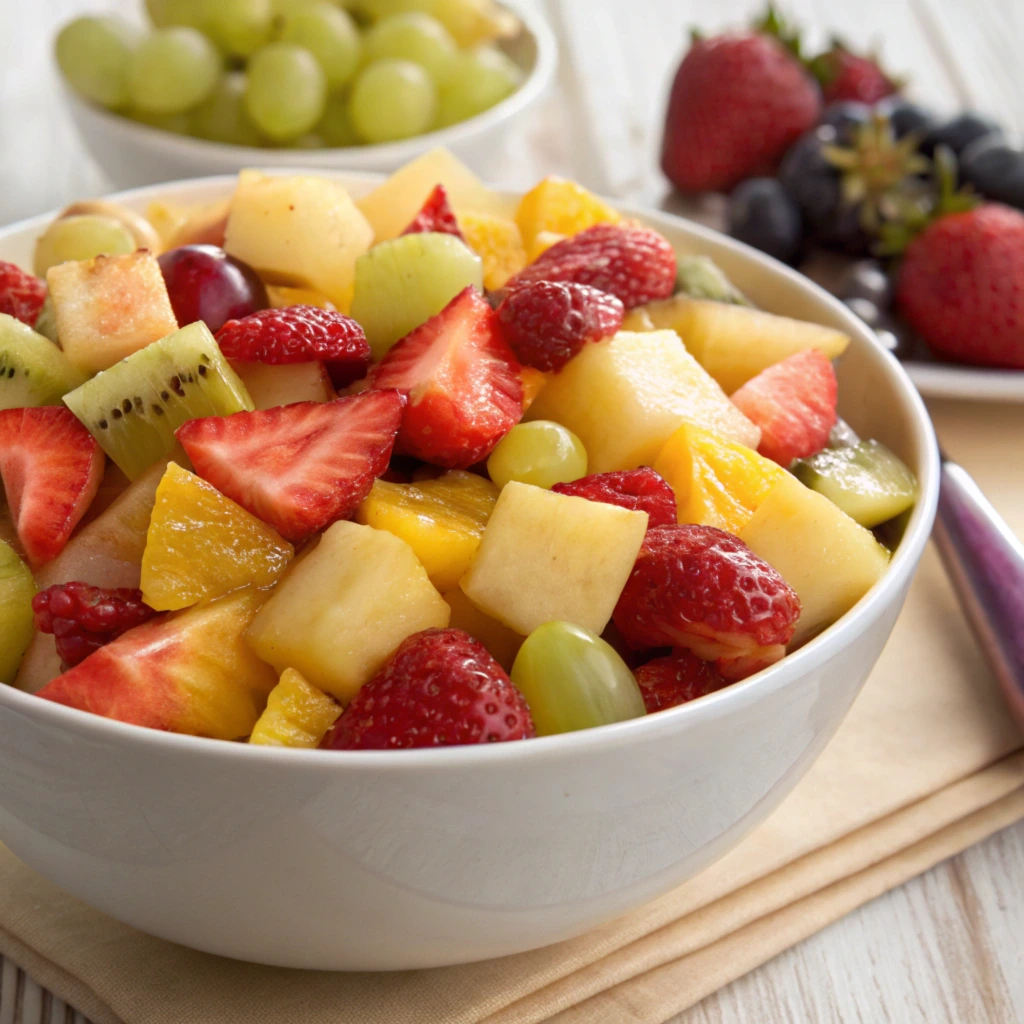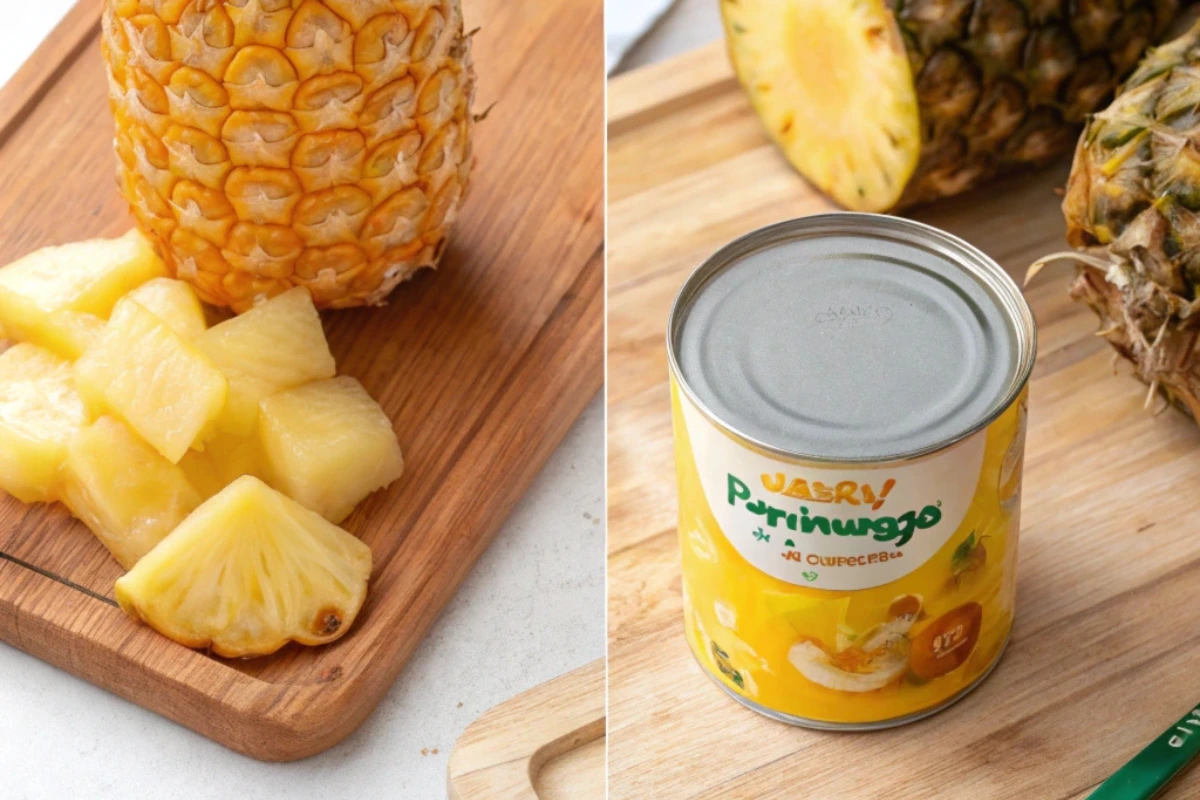Introduction: The Role of Pineapple in Recipes
Pineapple is a tropical fruit loved for its balance of sweetness and acidity, making it a versatile ingredient in both savory and sweet dishes. One common dilemma many cooks face is deciding whether canned pineapple can replace fresh. This question matters because ingredients’ flavor, texture, and nutritional value significantly impact the final dish.
In many households, fresh pineapple may not always be accessible, while canned pineapple offers convenience and a longer shelf life. To help you navigate this choice, this article explores when canned pineapple works well, when fresh is better, and how to make substitutions effectively without compromising the quality of your recipes.
Fresh and Canned Pineapple: Key Differences

Before deciding to use canned pineapple in place of fresh, it’s important to understand how they differ. Fresh pineapple is known for its juicy, firm texture and vibrant flavor. It also contains bromelain, an enzyme with unique culinary and nutritional benefits. On the other hand, canned pineapple undergoes heat processing, which softens its texture and alters its flavor. If you’re curious about how pineapple transforms during cooking, you can explore what does pineapple do in baking? to better understand its impact on recipes.
On the other hand, canned pineapple undergoes heat processing, which softens its texture and alters its flavor. Often packed in syrup or juice, it may have added sugar that increases sweetness. Here are the main distinctions:
- Texture: Fresh is firmer, while canned is softer.
- Flavor: Fresh offers a tangy, natural taste, while canned is sweeter.
- Nutrients: Some enzymes and vitamins in fresh pineapple may be reduced during canning.
These differences highlight why choosing the right type of pineapple depends on the recipe.
When to Use Canned Pineapple Over Fresh
In some situations, canned pineapple can serve as an excellent alternative. Its convenience, affordability, and consistent quality make it a go-to ingredient for many recipes. For those exploring creative ways to use canned pineapple, check out creative pineapple casserole recipe variations to discover practical and flavorful ideas.
When Canned Works Best:
- Baking: The softer texture of canned pineapple is ideal for cakes and muffins.
- Smoothies: Canned pineapple blends easily and eliminates the need for peeling and chopping.
- Pantry Cooking: Canned pineapple’s long shelf life makes it a reliable ingredient for spur-of-the-moment dishes.
- Budget-Friendly Options: Often cheaper than fresh, it’s a practical choice for cost-conscious cooks.
These advantages make canned pineapple a viable option in many culinary contexts, especially when saving time is a priority.
Benefits of Choosing Fresh Pineapple Over Canned
While canned pineapple is convenient, there are instances where fresh is the superior choice. Recipes that rely on natural textures and vibrant flavors benefit most from fresh pineapple.
When Fresh is Better:
- Raw Applications: In salads or fruit salsas, fresh pineapple adds a satisfying crunch and lively flavor.
- Grilled Dishes: Fresh pineapple’s firm structure holds up better when grilled.
- Marinades: The bromelain in fresh pineapple makes it effective for tenderizing meat.
- Health-Focused Recipes: Fresh retains more nutrients and natural enzymes than canned.
In these cases, fresh pineapple’s unique qualities enhance both the appearance and taste of the dish.

Tips for Substituting Fresh and Canned Pineapple
When fresh pineapple isn’t available, canned pineapple can be a suitable substitute with some adjustments. Follow these tips to ensure a seamless transition without compromising your dish.
Practical Substitution Tips:
- Drain Excess Liquid: Remove any extra syrup or juice to prevent dishes from becoming overly sweet.
- Balance Flavors: If the canned version is sweetened, reduce other sugars in your recipe.
- Modify Cooking Time: Softer canned pineapple may cook faster than fresh.
- Use Canned Juice Creatively: The leftover juice can enhance sauces, marinades, or drinks.
By making these simple modifications, you can effectively use canned pineapple in most recipes while maintaining their intended flavor and texture.
Combining Fresh and Canned Pineapple for Unique Dishes
From sweet treats to savory dishes, pineapple plays a starring role in countless recipes. Choosing between fresh and canned often comes down to the recipe’s requirements.
- Main Courses: In savory dishes like stir-fry or baked ham, canned pineapple performs admirably due to its consistent sweetness and texture.
- Desserts: Pineapple upside-down cake and fruit salads often use canned pineapple for its syrupy sweetness, though fresh chunks can provide an exciting textural contrast.
- Smoothies: Both types work well, but canned pineapple’s added juice simplifies the process by combining liquid and fruit in one step.
In most scenarios, canned pineapple is a practical option, but for recipes emphasizing crunch or tang, fresh pineapple is ideal.
Fresh and Canned Pineapple: Environmental Considerations
Using both fresh and canned pineapple in a single dish can bring out the best of both forms. Here are some ways to combine them:
- Layered Trifles: Add canned pineapple for its soft texture in layers and use fresh pieces for garnish.
- Tacos: Fresh pineapple provides a crunchy bite, while canned pineapple can be blended into a zesty salsa.
- Barbecue Marinades: Canned pineapple juice is perfect for marinades, while grilled fresh slices add a smoky flavor.
Balancing their unique qualities allows you to create dishes that stand out without compromising convenience.
Environmental and Practical Considerations
When deciding between fresh and canned pineapple, it’s important to think beyond flavor and texture. Environmental factors and kitchen needs also play a role.
- Fresh Pineapple: While delicious, it requires careful storage and has a short shelf life. Transportation of fresh pineapples also contributes to a higher carbon footprint.
- Canned Pineapple: This option reduces food waste, as it is fully usable and often comes in recyclable packaging. However, the canning process does use energy and resources.
Choosing between fresh and canned pineapple depends on what matters most to you—eco-friendliness, convenience, or freshness. Fresh pineapple generates biodegradable waste like peels and cores, which can be composted, while canned pineapple reduces food waste by being fully edible and often comes in recyclable packaging. For more insights into sustainable and practical uses of pineapple, visit the main site for additional resources and ideas.
Choosing canned pineapple over fresh can be a more eco-friendly option in certain situations, but fresh pineapple’s compostable waste and natural appeal remain significant benefits.
Finding the Right Balance in Your Cooking
Both fresh and canned pineapple have their place in the kitchen. Canned pineapple is a convenient choice for recipes requiring sweetness and uniform texture, while fresh pineapple shines when crunch and brightness are key. Understanding when to use each allows you to make the most of this versatile fruit, whether you’re baking, cooking, or enjoying it fresh.
Popular Uses for Pineapple in Recipes
Pineapple is a versatile ingredient that pairs well with both sweet and savory dishes. Understanding how each form performs in the kitchen can help you make the right choice.
Sweet Recipes
Canned pineapple is a common choice for desserts due to its softer texture and added sweetness. It works well in:
- Pineapple upside-down cake: The syrup in canned pineapple provides the perfect glaze for this classic dessert.
- Fruit salads: Canned pineapple blends easily with other fruits, but fresh pineapple offers a crunchier texture that can add contrast.
- Smoothies: Canned pineapple’s pre-cut pieces and juice make it easy to blend. Fresh pineapple, however, delivers a more vibrant flavor.
Savory Recipes
For savory dishes, pineapple adds balance with its sweetness:
- Stir-fries: Both fresh and canned work well, but canned pineapple’s softer texture integrates seamlessly with sauces.
- Pizza toppings: Fresh pineapple chunks add a tangy pop, while canned pieces bring uniform sweetness.
- Grilling: Fresh pineapple caramelizes beautifully, making it ideal for grilling. Canned pineapple can be grilled but may lose its structure.
Whether you’re making desserts or main dishes, knowing the desired texture and flavor can help you decide whether fresh or canned pineapple fits your needs.
How to Use Fresh and Canned Pineapple Together
Combining Fresh and Processed Pineapple in Recipes
Blending fresh and preserved pineapple can create delightful textures and flavors. Here are some inventive ideas to try:
- Tropical trifles: Include canned pineapple for its syrupy sweetness in the layers and fresh pieces for a crisp, colorful topping.
- Cocktails: Use juice from ripe pineapple for tangy flavor and canned slices for a decorative garnish.
- Tacos: Add raw pineapple chunks for crunch and canned juice to enhance sauces or dressings.
Why Combine?
Using both types allows you to achieve a dynamic balance between the bright flavor of fresh pineapple and the sweetness of canned. It’s especially effective in layered or multi-element dishes.
Health and Nutritional Differences
When substituting canned pineapple for fresh, it’s worth considering how the two differ nutritionally:
- Fresh Pineapple:
- Higher in vitamin C and natural enzymes like bromelain, which aids digestion.
- Free from added sugars or preservatives, making it a healthier option.
- Canned Pineapple:
- Often contains added sugars or syrups, though low-sugar options are available.
- Heat processing during canning may reduce some nutrients like vitamin C.
For those focused on maximizing nutritional benefits, fresh pineapple is the better choice. However, canned pineapple offers convenience, especially in recipes where other ingredients dominate the flavor.
Environmental and Practical Considerations
When deciding between fresh and canned pineapple, consider the impact on the environment as well as your kitchen needs.
Environmental Impact
- Fresh Pineapple:
- Higher carbon footprint due to the transportation of whole fruits from tropical regions.
- Generates biodegradable waste, such as peels and cores, which can be composted.
- Canned Pineapple:
- Reduces food waste because it’s pre-prepared and fully edible.
- Involves industrial processing and packaging, which increases energy consumption.
- Often packed in recyclable cans, but proper recycling depends on local systems.
Practical Considerations
- Fresh pineapple requires preparation, including peeling and coring, which takes time.
- Canned pineapple is ready-to-use, making it ideal for busy schedules or last-minute recipes.
Choosing between the two depends on what matters most to you—eco-friendliness, convenience, or freshness.
FAQs About Pineapple Substitutions
1. Can canned pineapple replace fresh in fruit salads?
Yes, canned pineapple works well in fruit salads due to its sweetness and soft texture. The pre-cut pieces save preparation time, making it convenient for quick recipes. However, fresh pineapple adds a tangy crunch and vibrant flavor that elevate the overall texture of the salad. If you want a mix of textures, you can combine the two, using canned pineapple as a base and fresh chunks as a garnish. Remember to drain canned pineapple thoroughly to avoid an overly watery salad.

2. Is fresh pineapple better for grilling?
Fresh pineapple is ideal for grilling because its natural sugars caramelize beautifully when exposed to heat, creating a smoky, sweet flavor. The firmer structure of fresh pineapple also ensures it holds up well during grilling. Canned pineapple can be used, especially in a pinch, but it is softer and may break apart on the grill. To prevent this, use thick rings or pieces and grill them briefly over medium heat. Fresh pineapple’s tangy flavor complements the caramelization process better, making it the preferred choice for grilled recipes.
3. How does canned pineapple affect baking?
Canned pineapple is excellent for baking due to its consistent sweetness and moisture content. Its syrupy quality helps keep cakes and muffins moist, making it a reliable choice for recipes like pineapple upside-down cake. However, if substituting fresh pineapple, be mindful of its higher water content and adjust the recipe by reducing other liquids slightly. Fresh pineapple may also introduce a sharper tang, which can alter the flavor balance. When using canned pineapple, choose varieties packed in juice instead of syrup for a less sugary result.
4. Is there a noticeable taste difference between fresh and canned pineapple?
Yes, there is a noticeable taste difference between the two. Fresh pineapple has a tangy, vibrant flavor and a natural juiciness that makes it a refreshing option in uncooked dishes. Canned pineapple, on the other hand, is sweeter and milder, often due to added syrup or juice during processing. While canned pineapple is more uniform in taste and texture, fresh pineapple offers a bright complexity that enhances dishes like salads and grilled recipes. The choice depends on whether the dish benefits from a fresh, crisp tang or a soft, consistent sweetness.
5. Which is healthier: fresh or canned pineapple?
Fresh pineapple is generally healthier as it contains no added sugars or preservatives and retains more nutrients, including vitamin C and bromelain, a natural enzyme with potential anti-inflammatory benefits. Canned pineapple, while still nutritious, may lose some of its vitamin content during the canning process and often includes added sugars if packed in syrup. To make a healthier choice, opt for canned pineapple packed in its own juice or water rather than syrup. While both forms offer health benefits, fresh pineapple is the superior choice for those prioritizing nutrition.
Tips for Choosing Between Fresh and Canned Pineapple
Here are some practical tips to help you decide:
- For crisp, tangy textures: Go with fresh pineapple in salads or grilled dishes.
- For consistent sweetness: Opt for canned varieties in baking or smoothies.
- If you’re short on time: Canned pineapple is ready-to-use and a convenient choice.
- For eco-friendly decisions: Think about the balance between food waste (fresh) and the energy used in canning processes.
Understanding these differences ensures that you make the best choice for your recipes and preferences.
Conclusion: Making the Most of Pineapple in the Kitchen
Fresh and canned pineapple each have unique strengths, and neither is inherently better than the other. Fresh pineapple offers a vibrant, natural taste perfect for dishes emphasizing texture, while canned pineapple provides convenience and a reliable sweetness for everyday cooking.
By recognizing when to use fresh or canned—and even combining the two—you can enjoy pineapple’s versatility across a range of recipes. With the right balance, this tropical fruit will continue to be a star ingredient in your kitchen.

